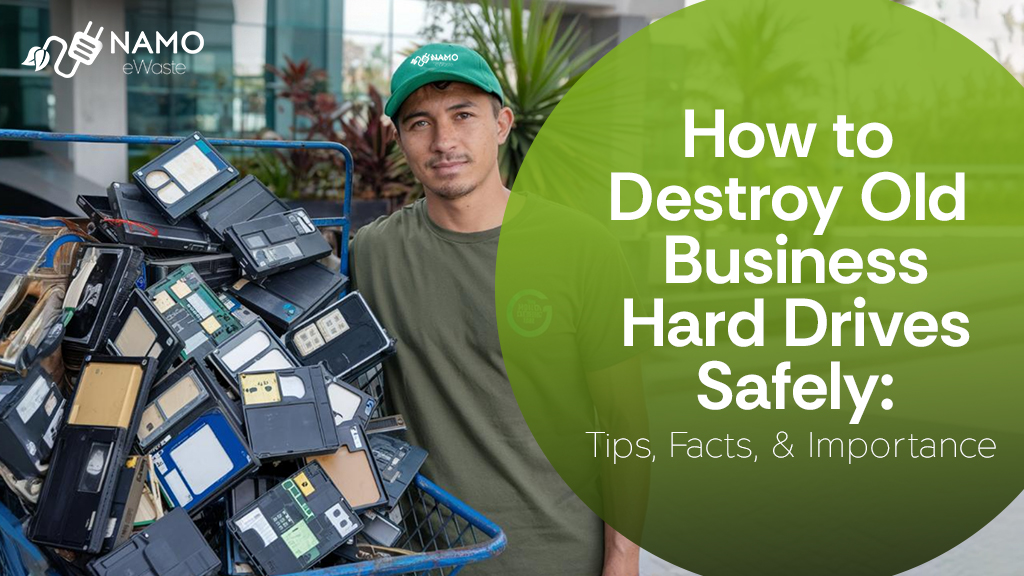Do you know what happens to your old antique business hard drives? Chances are that if you are like most people, then you just throw them out like regular trash. But do you know that this can pose a considerable security threat?
An old hard drive has business, personal data, correspondence, documentation, photos, videos, and other stuff that can be used by a third party to deceive you and take control of your digital identity. That is why it is advisable to delete them with security to avoid misuse of the information. In this blog post, you’ll learn the details of hard drive destruction, when to do it properly, and the ways to do it.
The Importance of Secure Hard Drive Destruction
- Data Security:
When old hard drives are thrown away, they are not destroyed, and this exposes the business to information technology theft. Erasing files or using a data wiping method does not delete files; it merely conceals them. This information can be retrieved by cybercriminals, hence posing a security threat. The National Cyber Security Alliance supports the data revealing that 60% of small businesses suffer closure within six months of a cyberattack and that discarded hard drives are often vulnerable.
- Legal Implications:
Governments and regulatory organizations demand higher levels of data protection legislation, such as GDPR for the EU member countries or HIPAA for the United States. It also applies these laws that require that personal data should be protected and disposed of when the data is not necessary, and the process should also be secure. The law also provided that any failure to observe all the provisions of the law is punishable by stiff fines.
- Environmental Impact:
Apart from security and legal implications, improper disposal of hard drives is a major reason for e-waste. The Global E-waste Monitor 2020 revealed that 6 million metric tons of e-waste were produced in 2019 and predicted to rise to 74 million metric tons by 2030. Hard drives are composed of dangerous elements like lead, mercury, and cadmium that, when disposed of in landfills, pollute the soil and water systems.
Hard Drive Disposal: Separating Fact from Fiction
Myth 1: Deleting Files Removes Data Permanently.
Fact: When you delete a file, the data does not disappear from your hard drive. Rather, the operating system simply marks that space as free to use for new information; the original data thus stays intact and can easily be recovered using recovery software. In fact, according to a report from Blancco Technology Group, nearly 40 % of second-hand drives purchased online retained recoverable data, showing how vulnerable deleted files are.
Myth 2: Physical destruction is not essential if software wiping has been performed.
Fact: Software wiping is effective, but it can’t be strictly relied on, especially for modern SSDs. Physical destruction methods, such as shredding or crushing, are more conclusive in the deletion of data. A study from Vanson Bourne recently found that 40 percent of IT professionals still recommend using both software wiping and physical destruction to ensure the best outcome in hard drive destruction.
Techniques for Deletion of Old Business Hard Drives
There are many ways of ensuring destruction on hard drives, safely and securely. Here are some reliable techniques:
- Data Wipe by Professional Wipe Tools
Data wiping entails overwriting the hard drive’s contents with random data repeatedly, rendering the original information significantly more difficult to retrieve. Commonly utilized tools, such as DBAN (Darik’s Boot and Nuke), facilitate this process; however, this approach is not infallible, particularly when it comes to contemporary SSDs that demand specialized wiping techniques. For absolute reassurance, businesses ought to contemplate pairing this method with physical destruction. - Degaussing
This employs a very strong magnetic field that would interfere with the information stored on a hard drive and render it unreadable. This works particularly well for traditional HDDs (hard disk drives) but does not work with SSDs (solid-state drives) due to the different nature of the storage technology. Also, drives degaussed are normally unusable afterward. - Partnering with Certified E-Waste Recycling Providers
Certified e-waste recyclers, including Namo Ewaste, offer secure hard drive destruction. They ensure the hard drives are either physically destroyed or wiped clean before recycling in an environmentally responsible manner.
Conclusion
Safely destroying old business hard drives is crucial for safeguarding sensitive data, adhering to legal requirements, and reducing environmental impact. There are various effective methods available, from shredding to degaussing, that ensure complete data destruction. Yet, collaborating with a certified provider such as Namo Ewaste offers the assurance of secure, responsible, and eco-friendly disposal of your outdated hard drives.


